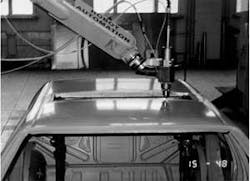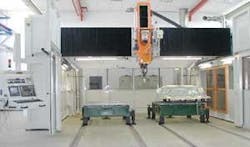Laser processing a limo
Beijing, China - The National Center of Laser Technology (NCLT) at the Beijing University of Technology was asked by China First Automobile Works (FAW) to assist in producing an enlarged version of its Red Flag automobile so that the inner space of this vehicle could be made larger and more comfortable for high-ranking officials of the Chinese government. The annual quantities of these enlarged cars is low, so to save money it was suggested that laser technology could be employed to cut the body into two parts, add a section, and laser weld the parts together again.
As a matter of historical interest, this application reminds one of the late 1980s when General Motors Cadillac division air freighted underbodies to Torino, Italy, where they were laser cut to remove a piece, which shortened the length, and then laser re-welded. This shorter underbody was then sent to Pininfarina (Torino) who had created a body which, when coupled to the modified underbody, became the Cadillac Allante. This assembly was then air freighted to Michigan where the engine, powertrain, and other accessories were added. Altogether about 3400 of these hybrids were built.
Figure 1 shows the roof of the enlarged Red Flag being welded after laser cutting by a high-power Nd:YAG laser with the beam manipulated by a robot.
NCLT, which also houses the Sino-German Center of Laser Technology, operates a well-equipped laboratory that includes the following: a 3.5kW slab CO2 laser, a 6kW CO2 laser with a three-axis motion system, pulsed 500W and 2.5kW CW Nd:YAG lasers with fiberoptic beam delivery, and other UV lasers.
NCLT has developed a CAD/CAM system based on AutoCAD aimed at auto body production, which allows programs to be created automatically rather than by teach-in. NCLT used this system to help FAW set up the 3D laser processing system shown in Figure 2, which is said to be the first 3D installation in the Chinese auto industry.
Information for this article was provided by Professor Chen Ji Min of NCLT. - DAB


